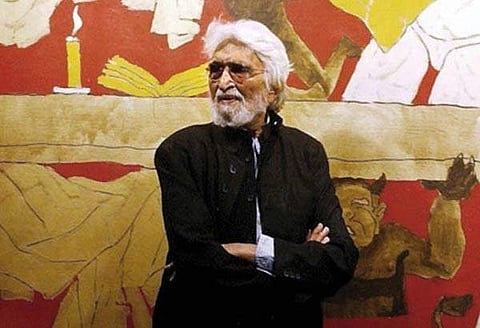

Ten years after he died in London, yearning to return home but unable to because of death threats against him, Maqbool Fida Husain remains one of India's most important and sought after artists whose oeuvre inspires art and conversations across the globe. An avid reader of history and mythology and Indian culture, a large part of Husain's art includes paintings of gods and goddesses in the context of the politics of the time, works that put him in the crosshairs of controversy.
With FIRs and persistent death threats, Husain was forced into self-exile, staying in Dubai and travelling to New York and London, where he died on June 9, 2011 at the age of 95, leaving behind a prodigious body of work. A year before that, he had taken citizenship of Qatar and those close to him remember his desperation to return to his own country, even if it was for half an hour for a cup of chai.
Pluralistic and political, he was the celebrity who began life painting cinema hoardings and remained always approachable, restless and yet dogged in the perseverance of his art. Curator Kishore Singh remembered the artist as exceptionally accessible. Recalling the period before the Asian Games of 1982 when Husain was painting murals for the ceiling of the Kanishka Hotel in New Delhi (now known as the Shangri La), the DAG curatorial director says he would often stop by for a chat and a cup of chai.
"I was a frequent visitor at the hotel, then under construction, and it was fascinating to see him scramble nimbly up the scaffolding to supervise the work. One could casually walk across to him to say hello, share a cup of tea, chat things that would have been difficult in today's culture of celebrity. He was approachable and accessible," Singh said.
Pluralistic and political, Husain was a striking figure with his silver mane and beard. India's barefoot Picasso as he was once called was refused entry to a south Mumbai club because he wouldn't wear shoes. The only thing predictable about his personality was in fact his unpredictability. His was a larger than life personality whose zeal and resilience came across in his bright palette, strong lines and of course his brawny horses.
He also had a keen interest in public personalities, be it Indira Gandhi, Mother Teresa, or Madhuri Dixit. The deep suffering of rural India was another recurrent theme of his paintings. The artist extraordinaire, experts recall, was as capable of creating works for an entire solo show in less than a week's time, as he was of turning up two hours late at his own live painting event. He was also the person asking to get a table booked at his favourite restaurant the day before he passed away.
While artists like (F N) Souza and (S H) Raza, and (V S) Gaitonde have made significant contributions to popularising Indian art among connoisseurs, for the common man it was always M F Husain, said the owner of Delhi's Dhoomimal gallery. One factor for Husain's immense popularity was his ease in public places that allowed people the liberty to watch an artist of his stature work.
rk by the artist.
